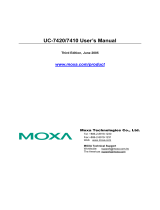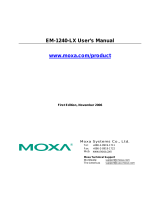
Table of Contents
1. Introduction ...................................................................................................................................... 1-1
2. Getting Started.................................................................................................................................. 2-1
Connecting to the Arm-based Computer ................................................................................................ 2-2
Connecting through the Serial Console ........................................................................................... 2-2
Connecting Through the SSH Console ............................................................................................ 2-4
User Account Management ................................................................................................................... 2-6
Switching to the Root Account ...................................................................................................... 2-6
Creating and Deleting User Accounts ............................................................................................. 2-6
Disabling the Default User Account ................................................................................................ 2-6
Network Settings ................................................................................................................................ 2-7
Configuring Ethernet Interfaces ..................................................................................................... 2-7
System Administration ........................................................................................................................ 2-8
Querying the Firmware Version ..................................................................................................... 2-8
Adjusting the Time ...................................................................................................................... 2-8
Setting the Time Zone ................................................................................................................. 2-9
Determining Available Drive Space ...................................................................................................... 2-10
Shutting Down the Device .................................................................................................................. 2-10
3. Advanced Configuration of Peripherals ............................................................................................. 3-1
Serial Ports ........................................................................................................................................ 3-2
Changing the Terminal Settings .................................................................................................... 3-2
USB Port ............................................................................................................................................ 3-3
USB Automount .......................................................................................................................... 3-3
CAN Bus Interface .............................................................................................................................. 3-3
Configuring the Socket CAN Interface ............................................................................................ 3-3
CAN Bus Programming Guide ........................................................................................................ 3-4
Real COM Mode Configuration .............................................................................................................. 3-6
Mapping TTY Ports ....................................................................................................................... 3-6
Mapping tty Ports (automatic) ....................................................................................................... 3-7
Mapping tty Ports Manually ........................................................................................................... 3-7
Removing Mapped TTY Ports ......................................................................................................... 3-7
4. Configuring of Wireless Connectivity................................................................................................. 4-1
Configuring the Cellular Connection ...................................................................................................... 4-2
Using Cell_mgmt ......................................................................................................................... 4-2
Dial-Up Step-by-Step ................................................................................................................... 4-4
Dial-Up ...................................................................................................................................... 4-4
Cellular Module ........................................................................................................................... 4-6
Configuring the NB-IoT/Cat. M1 Connection (UC-2114 and UC-2116 only) .......................................... 4-9
GPS ......................................................................................................................................... 4-10
Configuring the Wi-Fi Connection ........................................................................................................ 4-11
Configuring WPA2 Settings ......................................................................................................... 4-11
5. Security ............................................................................................................................................. 5-1
Sudo Mechanism ................................................................................................................................ 5-2
Cybersecurity—Moxa Security Utility ..................................................................................................... 5-3
Installing the Moxa Security Utility ................................................................................................ 5-3
Uninstalling the Moxa Security Utility ............................................................................................. 5-3
Utilizing the Moxa Security Utility .................................................................................................. 5-3
6. Firmware Update and System Recovery ............................................................................................ 6-1
Firmware Update and Set-to-Default Functions ....................................................................................... 6-2
Set-to-Default ............................................................................................................................. 6-2
Firmware Update Using a TFTP Server............................................................................................ 6-2
7. Programmer’s Guide ......................................................................................................................... 7-1
Linux Toolchain .................................................................................................................................. 7-2
Introduction................................................................................................................................ 7-2
Native Compilation ...................................................................................................................... 7-2
Cross Compilation ....................................................................................................................... 7-3
Example program—hello .............................................................................................................. 7-4
Example Makefile ........................................................................................................................ 7-5
Standard APIs .................................................................................................................................... 7-6
Cryptodev .................................................................................................................................. 7-6
WDT (Watch Dog Timer) .............................................................................................................. 7-6
RTC (Real-time Clock) .................................................................................................................. 7-8
Modbus ...................................................................................................................................... 7-9
Moxa Platform Libraries ..................................................................................................................... 7-10
Error Numbers .......................................................................................................................... 7-10
Platform Information ................................................................................................................. 7-11
Buzzer ..................................................................................................................................... 7-12


























